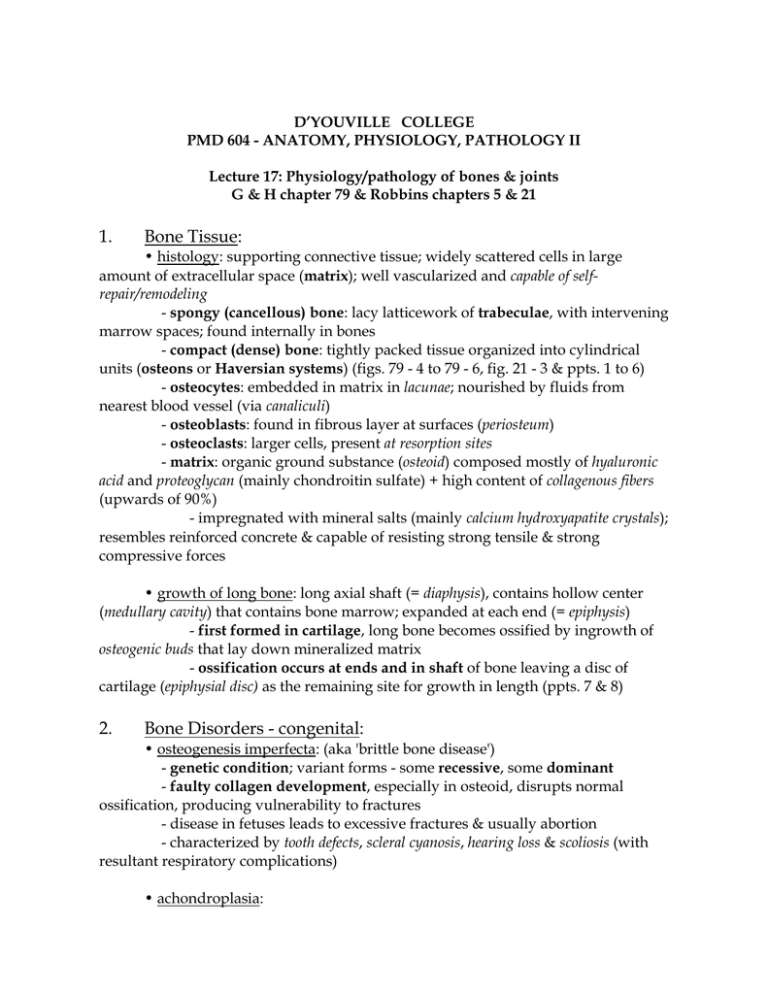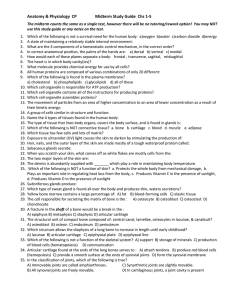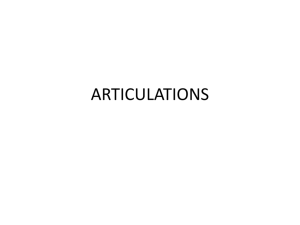RLF- PMD 17. Musculo#=ARW#s.doc
advertisement

D’YOUVILLE COLLEGE PMD 604 - ANATOMY, PHYSIOLOGY, PATHOLOGY II Lecture 17: Physiology/pathology of bones & joints G & H chapter 79 & Robbins chapters 5 & 21 1. Bone Tissue: • histology: supporting connective tissue; widely scattered cells in large amount of extracellular space (matrix); well vascularized and capable of selfrepair/remodeling - spongy (cancellous) bone: lacy latticework of trabeculae, with intervening marrow spaces; found internally in bones - compact (dense) bone: tightly packed tissue organized into cylindrical units (osteons or Haversian systems) (figs. 79 - 4 to 79 - 6, fig. 21 - 3 & ppts. 1 to 6) - osteocytes: embedded in matrix in lacunae; nourished by fluids from nearest blood vessel (via canaliculi) - osteoblasts: found in fibrous layer at surfaces (periosteum) - osteoclasts: larger cells, present at resorption sites - matrix: organic ground substance (osteoid) composed mostly of hyaluronic acid and proteoglycan (mainly chondroitin sulfate) + high content of collagenous fibers (upwards of 90%) - impregnated with mineral salts (mainly calcium hydroxyapatite crystals); resembles reinforced concrete & capable of resisting strong tensile & strong compressive forces • growth of long bone: long axial shaft (= diaphysis), contains hollow center (medullary cavity) that contains bone marrow; expanded at each end (= epiphysis) - first formed in cartilage, long bone becomes ossified by ingrowth of osteogenic buds that lay down mineralized matrix - ossification occurs at ends and in shaft of bone leaving a disc of cartilage (epiphysial disc) as the remaining site for growth in length (ppts. 7 & 8) 2. Bone Disorders - congenital: • osteogenesis imperfecta: (aka 'brittle bone disease') - genetic condition; variant forms - some recessive, some dominant - faulty collagen development, especially in osteoid, disrupts normal ossification, producing vulnerability to fractures - disease in fetuses leads to excessive fractures & usually abortion - characterized by tooth defects, scleral cyanosis, hearing loss & scoliosis (with resultant respiratory complications) • achondroplasia: PMD 604, lec 17 - p. 2 - - genetic condition, governed by dominant allele, involves automatic activation of fibroblast growth factor receptors (FGFR); blocks formation of cartilage cells - failure of cartilage formation in epiphyseal plates; produces various skeletal deformations, including dwarfism; many patients survive - homozygous dominant condition is more severe & generally lethal PMD 604, lec 17 - p. 3 - • osteopetrosis: - genetic condition governed by recessive allele - deficient osteoclast development results in abnormal bone formation characterized by increased density; - resulting bone is brittle, prone to fracture - sequelae: deficient marrow production (anemia, increased vulnerability to infection) results from bony encroachment on medullary cavities - thickened cranial floor causes cranial nerve deficits (blindness, deafness, Bell's palsy) due to nerve compressions - treatments: bone marrow transplant (osteoclasts derive from monocytes), calcitriol (modestly successful) 3. Bone Disorders - acquired: • osteoporosis (figs. 21 - 1, 21 - 4 & ppts. 9 & 10): - development of the condition is related to peak skeletal mass (a genetically determined trait that is lower in Caucasians and Asians, especially females) - progressive loss of bone mass appears to be due to resorption outpacing deposition as one ages or as a post menopausal condition - treatments include administration of vitamin D, calcium, osteoclast inhibitors; estrogen therapy for postmenopausal patients carries risks (MI, thrombosis, CVA & breast cancer) - preventive approach: promote healthy bone development with sound nutrition (especially adequate vitamin D & calcium) & exercise • Paget's disease: - possibly related to viral infection (emergence of latent virus from prior measles or mumps infections) that stimulates osteoclasts; affects mostly aged 60 and above - involves foci of abnormal bone formation (pagetic bone); coarse & poorly organized bone (osteitis deformans); may affect single bones (monostotic) or multiple bones (polyostotic) - characterized by repetitive periods of excessive resorption (vulnerability to fracture), followed by 'exuberant' deposition and resorption & finally by an osteosclerotic period of heavy bone deposition with reduced resorption - excessive density of skull bones may affect head posture or even cause compression fractures of cervical spine • rickets & osteomalacia: - rickets afflicts children and is caused by vitamin D deficiency due to dietary insufficiency (uncommon in Western world); responds well to vitamin D & calcium therapy - osteomalacia afflicts adults and is due to malabsorption of vitamin D or impaired renal retention of phosphate (causes deficient mineralization) - involves vulnerability to fractures but may be asymptomatic for years PMD 604, lec 17 4. - p. 4 - Disorders of Joints: • normal joint morphology: - synovial joints: located between bones articulating with each other - epiphyses are coated with articular cartilage & are enclosed in a synovial cavity that contains synovial fluid (lubricant) that is produced by synovial membrane; joint is enclosed externally in ligamentous capsule (ppts. 11 & 12) • osteoarthritis: (fig. 21 - 16b & ppts. 13 & 14) - primary osteoarthritis due to age-related deterioration of joint cartilage - secondary osteoarthritis (mostly in young people) is related to a contributing factor other than age, e.g., stress of athletic activity, traumatic injury - minimal involvement of inflammation - lesions derive from thinning out of articular cartilage: fissures develop & cysts of synovial fluid develop in these - irritated synovial membrane produces osteophytes or spurs - fibrosis of joint capsule derives from inflammatory damage - treatment with analgesics and anti-inflammatory drugs is usually beneficial • rheumatoid arthritis: (RA) - systemic condition affecting many other organs (heart, lungs, skin, etc.) as well as joints; joints affected are in hands, wrists, ankles & feet (less emphasis on weightbearing joints) - inflammatory disease that may have genetic basis, autoimmune basis or infection basis; in 80% of cases, presence in blood of rheumatoid factor (antibody against IgG) may substantiate the autoimmune etiology - pathogenesis (figs. 5 - 23, 5 - 25 & ppts. 15 to 18) involves cellular proliferation in synovial membrane, forming a sheet of cells (pannus) that overgrows joint cavity (includes synovial membrane cells & inflammatory cells) - cellular components of inflammation invade synovial fluid, attacking articular cartilage and underlying bone (cytokine action) - continued growth of pannus may cause fibrosis of joint capsule and eventual fusion of joint (ankylosis) - therapies include immobilizing affected joint(s), anti-inflammatory drugs and painkillers • gout: - excessive uric acid in blood, attributable to impaired excretion by the kidneys, (which may be provoked by drugs) or overproduction of uric acid (a waste product of purine metabolism); genetic defect is also possible - arthritis is caused by deposit of uric acid in joints; in advanced stages of gout, deposits may also occur in soft tissues (tophi) such as tendons & subcutaneous tissues (fig. 21 - 20 & ppt. 19 - men are afflicted more than women PMD 604, lec 17 - p. 5 - - asymptomatic period precedes attack of acute gouty arthritis; a second asymptomatic period intervenes before chronic tophaceous gout appears PMD 604, lec 17 5. - p. 6 - Disorders of Muscle: • Duchenne muscular dystrophy: - X-linked recessive allele is responsible, therefore young males are predominantly affected; genetic defect involves deficiency of a protein (dystrophin) that helps maintain integrity of sarcolemma - absence of stable membrane interaction with extracellular matrix provokes damage each time muscle fiber contracts; damaged muscle fibers can achieve some self repair but are overwhelmed and eventually replaced by fat or fibrous tissue - muscular clumsiness & weakness (skeletal muscle) or cardiac failure (cardiac muscle) result - contractures that develop can cause severe skeletal deformities (scoliosis or severe lordosis), which compromise respiratory function; death usually results from respiratory failure







